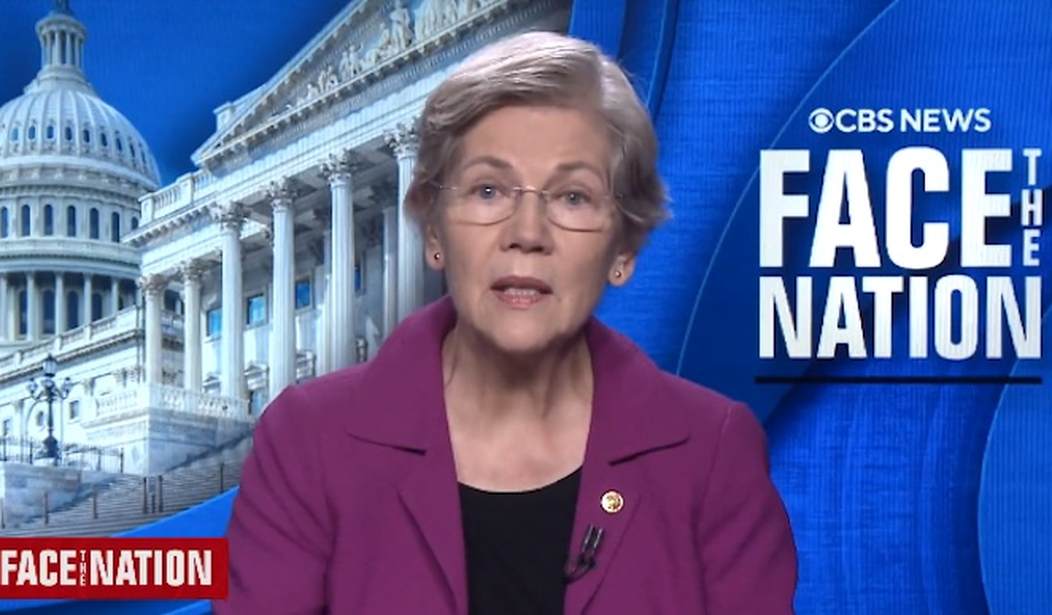First question: Should the FDIC pay off every depositor in the event of a bank failure regardless of caps?
Second question: Aren’t we doing that already, in practical terms? Joe Biden promised to make all depositors in Silicon Valley Bank whole in the FDIC closure of the politically connected institution, without exactly explaining how. A number of these depositors were small-business owners connected to venture capital firms that worked through SVB, or at least did until the bank failed.
Elizabeth Warren wants to make that official by raising the FDIC insurance cap — or eliminating it. On CBS’ Face the Nation, Warren suggested that depositors with up to $10 million in FDIC-member banks should automatically get all of their money back in similar situations:
Lifting the FDIC insurance cap would be “a good move," Sen. Warren said Sunday, and suggested up to $2 million, $5 million or $10 million.
Asked if she's talked with the White House on the proposal, she added, “it is one of the options that's got to be on the table right now." pic.twitter.com/w1Vt7PxkWL
— Face The Nation (@FaceTheNation) March 21, 2023
First off, we need to understand the purpose of FDIC insurance. It wasn’t to backstop businesses, but individual depositors. The original limit, set in January 1934, was $2500, which would be roughly $56,000 in inflation-adjusted (CPI) dollars today. Congress raised it six months later to $5,000, which would be worth $113,000 today. Contra Warren, the FDIC didn’t intend to backstop people of wealth, but rather to ensure that people didn’t lose their personal cash reserves in a bank failure. It was to make sure that individuals could pay their personal bills, especially their mortgages, not “non-profits” as Warren claims here.
Congress has raised the FDIC cap six times since July 1934, the final time in October 2008 in the financial-sector meltdown. That increase to $250,000 was and still is the highest value in real dollars in the FDIC’s history of cap lifts; 1974’s $40K would be worth $237K today, and 1980’s hike to $100K would be worth $227K in today’s dollars. There may be an argument for indexing the cap level to inflation, and assuming that the FDIC can fund it, that’s a debate worth having.
But a $10 million cap would be a massive change to the FDIC system — and what it specifically ensures. Imagine if Franklin Delano Roosevelt had announced in January 1934 that he would backstop deposits up to $438,000 — which is what $10 million would be in 1934 dollars. Americans would have roared that FDR was trying to bail out his wealthy pals, including some who may have contributed to the risky behaviors that created the bank failures in the first place. And they would have been correct.
That’s precisely what this would do as well. First, it would make bank failures massively more expensive for the FDIC and therefore for the federal government. The level of guaranteed deposits in a couple of bank failures might crash the FDIC system. That could force better management of capitalization, but what it would most likely accomplish is a massive consolidation in banking as smaller and regional banks could no longer afford the compliance costs and capital restrictions. Insurance premiums alone would skyrocket to levels that small and regional banks would find unaffordable. It would become Too Big To Fail On Steroids.
And as we have seen, that approach didn’t prevent the collapses at SVB and Signature, as well as the weakening of other banks. Despite the supposed new restrictions on capital support after 2008, the Fed’s rate-hike series to control inflation has undermined banks that the FDIC presumed were already solid. In the case of SVB, their venture-capital risks appears to have at least contributed to that instability as well.
If banks engage in too much risky behavior, a failure is the proper corrective. If the government starts bailing everyone out of failures, then the potential costs of risk drop — which incentivizes riskier behavior. The reason we have FDIC is to make sure the small depositors and their personal funds are protected from the consequences of risky behavior by bank executives and their investors.
If we spread out the backstop to include most or all of that latter class, then get ready for a lot more bank failures — and a massive expansion of an already-onerous national debt to cover them.
Now, one can argue that the federal government is already doing this on an ad hoc basis, as I mentioned at the start. That doesn’t make it a good idea, especially on a systemic level. Eventually, it would lead to either a banking oligarchy — or, as I suspect Warren really wants, a nationalized banking system in the US. Those are the only end games for federal guarantees of deposits at this level that would encompass a sum so vast that premiums could never possibly keep up with the risk.
Addendum: Who keeps $10 million in a bank account, anyway? That’s not a “payroll” amount for small businesses. That kind of wealth normally should get invested in stocks, bonds, mutual funds, and other securities, including Treasury bonds or notes. And the FDIC does not cover any of those with their insurance, because they are secured by other means.








Join the conversation as a VIP Member